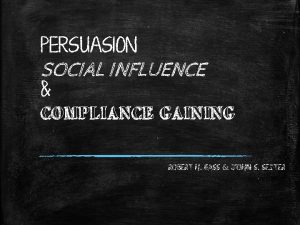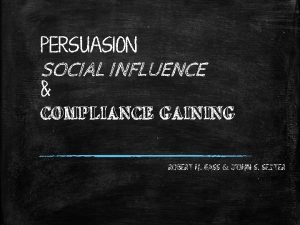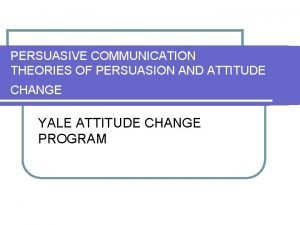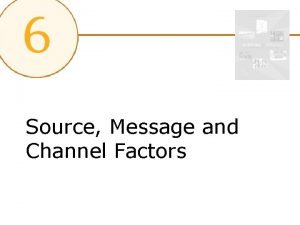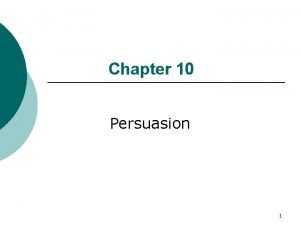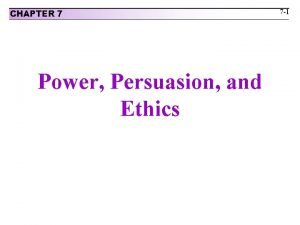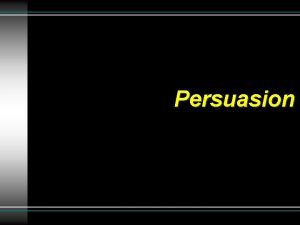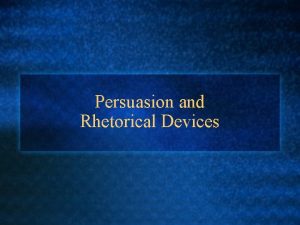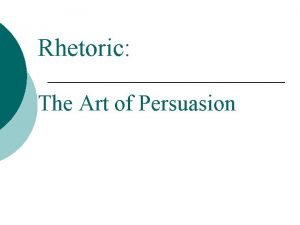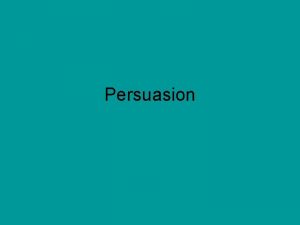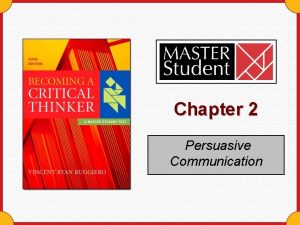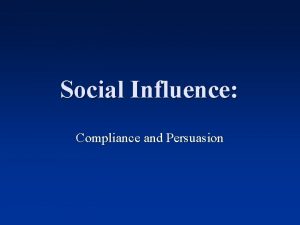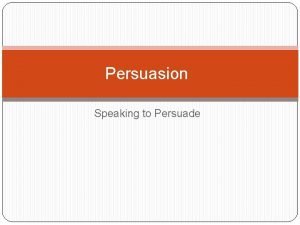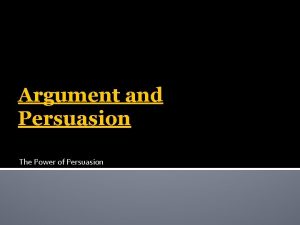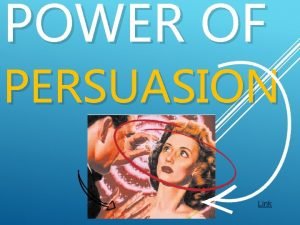CHAPTER 7 Persuasion Compliance and Power Persuasion communication
















- Slides: 16

CHAPTER 7 Persuasion, Compliance, and Power

Persuasion: communication for the specific purpose of changing other people’s minds n n Characteristics of the persuader: attractiveness (lowered defenses, halo effect), style of presentation (confident, upbeat, fluent), and credibility (expertise and trustworthiness) Characteristics of the persuasive message: two-sided arguments, emotional elements (for example, fear appeals), audience comprehension and acceptance, moderation (i. e. , tailor your message to the people you are addressing)

Persuasion: communication for the specific purpose of changing other people’s minds n Two paths to persuasion: “mindful” and “mindless” persuasion n The central route to persuasion (based on the quality of the arguments and supporting facts) n The peripheral route to persuasion (based on cues unrelated to the issue) n Involvement, distraction, positive versus neutral mood

Two routes to persuasion: central and peripheral

Factors that determine which route to persuasion will be taken n n Degree of involvement Need for cognition Neutral vs. positive mood Degree of distraction

Compliance (a form of influence based on direct requests): some useful strategies Simplest strategy: Just ask. Mindless compliance: giving an apparent (pseudo)reason Self-presentation (impression management) n n n n Ingratiation Self enhancement & name dropping Self-deprecation Self-disclosure Warning: These strategies can backfire Multiple requests n n n Foot-in-the-door (Freedman & Fraser, 1966) Door-in-the-face (reciprocal concessions)


Compliance (a form of influence based on direct requests): some useful strategies Simplest strategy: Just ask. Mindless compliance: giving an apparent (pseudo)reason Self-presentation (impression management) n n n n Ingratiation Self enhancement & name dropping Self-deprecation Self-disclosure Warning: These strategies can backfire Multiple requests n n n Foot-in-the-door (Freedman & Fraser, 1966) Door-in-the-face (reciprocal concessions)

Freedman and Fraser (1966) Small request n No request n large request 52. 8% large request 22. 2%

Compliance: some useful strategies Simplest strategy: Just ask. Mindless compliance: giving an apparent (pseudo)reason Self-presentation (impression management) n n n n Ingratiation Self enhancement & name dropping Self-deprecation Self-disclosure Warning: These strategies can backfire Multiple requests n n n Foot-in-the-door (Freedman & Fraser, 1966) Door-in-the-face (reciprocal concessions)

The door-in-the-face technique: Reciprocal concessions

Compliance: some useful strategies n Resisting unwanted influence n n Forewarning (inoculation) Attitudinal politics (holding out for the best deal) Counterarguing and playing “devil’s advocate” Potential pitfalls: indifference and distraction

Power: beyond influence and persuasion n The difference between influence and power n n n Control, status, privilege, and need for power Potential pitfalls: inefficiency and low morale Sources of individual power n n n Reward power: control over valued resources Coercive power: control of punishments Legitimate power: control based on rank Referent power: control based on attraction Expert power: control based on knowledge

Power: beyond influence and persuasion n Sources of individual power: Independent or linked? n n Reward and coercive power are often linked Coercive power may reduce referent power Legitimate power may lead to referent power Hazards to avoid in your influence attempts n n n The slime effect (“licking upward, kicking downward”) Reactance: a boomerang effect of persuasion Metamorphic effects of power and persuasion

Tacky power n n n Ostentatious offices Special perks such as special dining rooms, bathrooms, and exercise facilities Layers of office staff and “cronies” Formal titles Specialized vocabulary

Organizational politics n n Who you know, who is your ally, who owes you A middle- and upper-management game (not blue collar) High role ambiguity, unclear performance evaluation criteria Tactics of influence n n n n Cultivate the right allies Count on reciprocity Project competence and confidence Remember the value of being liked Be persuasive Make a good first impression Avoid “dirty tricks” (false rumors, information control, hidden agendas)
 Persuasion social influence and compliance gaining
Persuasion social influence and compliance gaining Persuasion social influence and compliance gaining
Persuasion social influence and compliance gaining Persuasive communication
Persuasive communication Power triangle formula
Power triangle formula Persuasive leverage
Persuasive leverage Persuasion matrix in advertising example
Persuasion matrix in advertising example Communication persuasion matrix
Communication persuasion matrix Communication-persuasion matrix
Communication-persuasion matrix Power bi compliance
Power bi compliance Persuasion chapter 9
Persuasion chapter 9 Persuasion chapter 7
Persuasion chapter 7 Solar power satellites and microwave power transmission
Solar power satellites and microwave power transmission Potential power
Potential power What is dispersive power of grating
What is dispersive power of grating Cognitive dissonance
Cognitive dissonance Cognitively based attitude
Cognitively based attitude Petty and cacioppo's model of persuasion
Petty and cacioppo's model of persuasion
